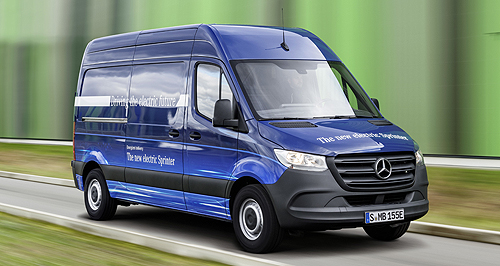Make / Model Search
Future models - Mercedes-Benz - Sprinter - eMercedes-Benz Vans goes green with eSprinterNo charge delivery: Mercedes-Benz is planning to release its all-electric eSprinter van next year, hoping to capture the inner-city delivery market with an emissions-free powertrain. 2019 production slated for all-electric Mercedes-Benz Sprinter large vanGallery Click to see larger images 8 Feb 2018 By TUNG NGUYEN in GERMANY MERCEDES-BENZ Vans is putting its faith into all-electric drivetrains for its large Sprinter and mid-size Vito vans, forgoing hybrid for a completely emissions-free solution due to the larger payload advantage. Speaking to Australian journalists at the reveal of the new-generation Sprinter in Duisburg, Germany, global head of Mercedes-Benz Vans Volker Mornhinweg said research concluded that an all-electric powertrain would be a more viable solution in more markets around the world. “First of all, we had a look at our huge markets, what are the circumstances there, and therefore we saw that if we go for the hybrid, the hybrid is quite expensive on the one hand,” he said. “On the other hand, you then have two powertrains onboard and that means you would lose payload for our customers. “Especially in countries where we have big cities – where the urban areas are more or less regions –therefore we said it makes not huge sense especially in these areas, hybrids really make no sense. “In countries where you do not have these big urban places, there it might be hybrid an opportunity, but from an overall perspective, these regions are pretty small.” While Mr Mornhinweg conceded that a hybrid light-commercial van would make more sense in places like Australia due to the longer travel distances, he said these markets only made up about 20 per cent of global sales. “(Big cities) are our home field, the last mile for example, and therefore we said, especially in countries where there are emissions regulations … are extremely strict, we saw that it will be difficult for a hybrid to fulfil the regulations, the targets,” he said. “Then it would be decided we would go full electric because that (covers) 80 per cent of the market. “The full-electric Sprinter or Vito is a very viable product because it makes a lot of sense.” The all-electric eVito is already available to order for European customers with deliveries starting mid-year, while the eSprinter – revealed alongside the third-generation Sprinter – is scheduled for an on-sale date next year. The eVito features a 41.4kWh battery that is good for a driving range of around 150km, with cold weather conditions and a full payload of 1073kg reducing the distance to just 100km. Outputs are measured at 84kW/300Nm, while Mercedes claims the battery can be fully charged in six hours. Meanwhile, the upcoming eSprinter will feature a payload of up to 1000kg with a 11 cubic metre load volume. Using a scalable battery pack, it is understood the base version will run three batteries with customers able to option a fourth, depending on requirements. Although no driving range or battery capacity has yet to be revealed, the eSprinter is expected to sport at least 100km of driving range for ‘last mile’ deliveries, usually the leg from depot to customer. Both eVito and eSprinter are confirmed for the Australian market, although timing on when both emissions-free vans will be made available outside of Europe is still to be determined. Mr Mornhinweg said there would be no limit on production of the electric LCVs given they will be built on the same production lines as their internal combustion counterparts. “That means we have enough capacity on board … it is the customer’s decision finally how many EVs we have to produce or how many combustion – diesel or gasoline engines – because we have the flexibility in our facilities,” he said. “Maybe some companies have …. built up a small facility where they can then produce 3000 or 5000 or 10,000 units a year of EVs, but we don’t care.” Mr Mornhinweg said the adoption of electric powertrains in light-commercial vans is much easier than passenger cars, given their longer wheelbases and the ease of packaging the batteries, and that the Van division has been leveraging the technology already developed. “The guys on the pass (enger) car side, they already developed some batteries for their hybrid products,” he said. “And in Kamenz, in the eastern part of Germany, we have a battery facility there for the group and they already developed batteries. “We could now use these batteries, which they use for hybrids … that really speeds up our market introduction tremendously because we don’t have to wait. “We thought the possibility may be even higher than the pass(enger) car side that this kind of powertrain makes sense.”  Read more7th of February 2018  Mercedes-Benz broadens appeal in new SprinterBody, engine, drivetrain choices push new-gen Merc Sprinter van to 1734 variantsAll future modelsSprinter pricing
Motor industry news |
Click to shareMercedes-Benz modelsResearch Mercedes-Benz All future modelsSprinter pricing
Motor industry news |












 Alfa Romeo
Alfa Romeo Abarth
Abarth Audi
Audi Aston Martin
Aston Martin BMW
BMW Bentley
Bentley Ferrari
Ferrari Chevrolet
Chevrolet Ford
Ford Fiat
Fiat GWM
GWM Foton
Foton Hyundai
Hyundai Honda
Honda Jaguar
Jaguar Isuzu
Isuzu Kia
Kia Jeep
Jeep Land Rover
Land Rover Lamborghini
Lamborghini Maserati
Maserati Lexus
Lexus McLaren
McLaren Mazda
Mazda Mercedes-Benz
Mercedes-Benz Mitsubishi
Mitsubishi Mini
Mini Peugeot
Peugeot Nissan
Nissan Ram
Ram Porsche
Porsche Rolls-Royce
Rolls-Royce Smart
Smart Skoda
Skoda Suzuki
Suzuki Subaru
Subaru Toyota
Toyota Tesla
Tesla Volvo
Volvo Zeekr
Zeekr







Facebook Twitter Instagram